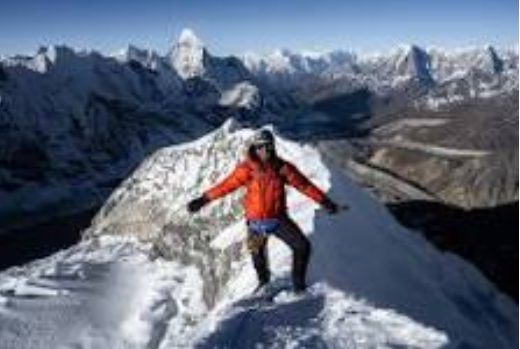Adventure in the Himalayas
Island Peak (6,189 meters/20,305 feet), also known as Imja Tse, is one of the most popular trekking peaks in Nepal. Located in the Everest region, Island Peak climbing offers mountaineers the opportunity to experience high-altitude climbing with a relatively accessible and non-technical ascent compared to some of the more challenging Himalayan peaks. The summit of Island Peak provides stunning panoramic views of the Everest region, including Mount Everest, Lhotse, Nuptse, and Ama Dablam. For many climbers, this trek serves as a stepping stone toward larger Himalayan peaks and an unforgettable introduction to high-altitude mountaineering.
Climbing Experience
Island Peak Climbing Adventure is typically a 14 to 16-day expedition that combines trekking and climbing. The journey begins with a scenic flight from Kathmandu to Lukla, the gateway to the Everest region. From Lukla, trekkers follow the classic Everest Base Camp trek route, passing through famous villages like Namche Bazaar and Tengboche. The trek provides climbers with the opportunity to acclimatize gradually, which is crucial for success in high-altitude climbing.
The trek to Island Peak base camp involves passing through the Khumbu Valley and climbing through stunning terrain, including forests, alpine meadows, and glaciers. After reaching the base camp, located at 5,200 meters (17,060 feet), climbers typically rest and acclimatize for a few days before attempting the summit. The surrounding scenery is truly breathtaking, with views of the towering peaks of the Everest region, such as Makalu, Lhotse, and Ama Dablam.
Island Peak’s ascent is generally considered non-technical, although it requires basic mountaineering skills, including the use of crampons, ice axes, and harnesses. The climbing route involves several stages, including crossing a steep snow and ice slope that leads to the summit ridge. From there, climbers need to navigate a narrow, exposed ridge before reaching the top of the peak. While the climb is challenging, it is accessible to climbers with previous trekking or climbing experience, making it an excellent first Himalayan climb.
Physical and Technical Challenges
While Island Peak climbing is considered a relatively non-technical climb, it still presents a number of challenges. The altitude is the primary concern, with the base camp situated at a high elevation and the summit reaching over 6,000 meters. As with any high-altitude climb, proper acclimatization is critical to prevent altitude sickness. Climbers should plan for gradual altitude gains and allow time for rest and recovery.
The final push to the summit requires the use of basic climbing gear, including ice axes, ropes, and crampons, as climbers navigate icy and sometimes steep terrain. The section before reaching the summit ridge can be demanding, requiring both physical stamina and mental focus. Though the climb is achievable for climbers with basic mountaineering skills, it is important to be prepared for the physical exertion and exposure to extreme weather conditions, including cold winds and snow.
Cultural and Scenic Highlights
One of the most rewarding aspects of Island Peak climbing is the opportunity to experience the culture and beauty of the Everest region. The trek to the base camp takes climbers through Sherpa villages where trekkers can interact with locals and learn about Sherpa culture and traditions. Monasteries such as Tengboche Monastery offer spiritual insight and moments of reflection, while traditional villages like Namche Bazaar and Pangboche allow climbers to observe the unique way of life in this high-altitude region.
The mountain views from the summit of Island Peak are unforgettable. From the top, climbers are treated to 360-degree views of the Everest region, including Everest itself, Lhotse, Makalu, and the Khumbu Icefall. The combination of the climbing challenge and the surrounding natural beauty makes the expedition truly exceptional.
Preparation and Safety
To ensure a successful climb, proper preparation is essential. Climbers should have previous experience with trekking in high-altitude environments, and some basic mountaineering knowledge is highly recommended. Training in the use of crampons, ice axes, and ropes can make the climb more manageable and increase the chances of a successful summit. Physical fitness is important, as climbers will be trekking for long hours at high altitudes and will need strength and endurance to tackle the climb.
It’s also important to be prepared for variable weather conditions, including snow, rain, and high winds, which can impact the climb. Being mentally and physically prepared for the challenges ahead will ensure that climbers can enjoy a safe and rewarding experience.
Conclusion
Island Peak climbing offers an incredible opportunity for mountaineers to experience the thrill of climbing a Himalayan peak without the technical complexity of some of the region’s larger summits. The combination of spectacular views, cultural immersion, and a non-technical climb makes Island Peak an excellent choice for aspiring climbers looking to challenge themselves in the Everest region. With careful preparation, good acclimatization, and the right mindset, Island Peak is a climb that will leave you with a deep sense of accomplishment and unforgettable memories of Nepal’s stunning mountain landscapes.

